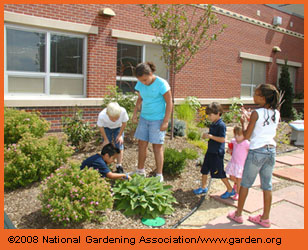Little Spaces; Big Results
Little spaces can produce big results by helping monarch butterflies, pollinators, birds, and other wildlife find places for food, water, shelter, and reproduction. Butterfly gardens in schoolyards, at home, in public spaces, or in naturalized areas can be extremely valuable to monarch butterflies.
Monarchs have two special needs: milkweed which is needed for breeding and flowering plants which are needed for nectar.
Milkweed
Many butterflies have a single plant required as a food source for their larval form called a host plant. Milkweed is the host plant for the monarch butterfly. Without milkweed, the larva would not be able to develop into a butterfly. Monarchs use a variety of milkweeds.
Over 100 species of milkweed exist in North America, but only about one fourth of them are known to be important host plants for monarch butterflies. For a list of beneficial species go to: Milkweed Species Beneficial to the Monarch Butterfly.
Nectar Plants
Adult monarchs feed on the nectar from flowers, which contain sugars and other nutrients. Unlike the larvae that only eat milkweeds, adult monarchs feed on a wide variety of nectar bearing flowers. They will visit many different kinds of flowers in their search for food.
An abundance of nectar sources is especially important for migrating monarchs. Monarchs that are preparing to migrate south to Mexico need to consume enough nectar to build up fat reserves. The food they eat before and during their migration south must not only power them through the long journey, but also must sustain them throughout the winter. Over-wintering monarchs feed very little or not at all. As monarchs migrate south, they will actually gain weight as they continue to feed on nectar bearing flowers.
In eastern North America, the monarchs leave the over wintering sites in the spring. Nectar is essential to making the journey to Texas. Nutrition from early spring nectar bearing wildflowers provides the energy and nutrients for these monarchs to develop their reproductive organs. When they arrive in Texas, they will breed and then die. As the new monarchs emerge they will make their way north. It will take three more generations of monarchs to complete their journey northward and then start the migratory cycle once again.
Nectar corridors are a series of habitat patches containing plants that flower at the appropriate times during the spring and fall migrations. These patches provide stopping-off points for the migrating butterflies to refuel and continue their journey. Having these islands of nectar sources is particularly important within large areas of urban and agricultural development. The discontinuous patches of nectar sources are “corridors” that monarchs will follow, like stepping-stones across a stream to complete their migration.
This information was from the USDA Forest Service's Monarch Butterfly in North America web page:
http://www.fs.fed.us/wildflowers/pollinators/Monarch_Butterfly/index.shtml
During the webcast, learn about:
- Summer habitat for monarchs, inner city habitat development, and schoolyard/backyard gardens
- Monarch biology, including the monarchs return to the north and the two-generation spring migration
- Citizen science opportunities including Journey North
- Environmental education
Here's how you can participate:
- Watch the webcast.
- Check out the lesson plans.
- Watch the short video segments.
- Take a Google Earth tour.
Links
For more information about habitat needs and gardening for butterflies, visit the following web pages:
Important Links
http://monarch.pwnet.org/trc/links.php
See the information about gardening for butterflies on this web site.
USDA Forest Service's Monarch Butterfly in North America:
http://www.fs.fed.us/wildflowers/pollinators/Monarch_Butterfly/index.shtml
and
http://www.fs.fed.us/wildflowers/pollinators/Monarch_Butterfly/habitat/index.shtml
Whether it’s a field, roadside area, open area, wet area, or urban garden; milkweed and flowering plants are needed for monarch habitat. Adult monarchs feed on the nectar of many flowers, but they breed only where milkweeds are found.
Monarch Watch
Monarchs need our help! Get involved in monarch conservation by creating a Monarch Waystation. For information, go to http://www.monarchwatch.org/waystations/.
For a photo guide and instructions on growing your own milkweed, go to http://www.monarchwatch.org/milkweed/index.htm.
For tips on starting your own garden and detailed plant lists, go to http://www.monarchwatch.org/garden/.


























